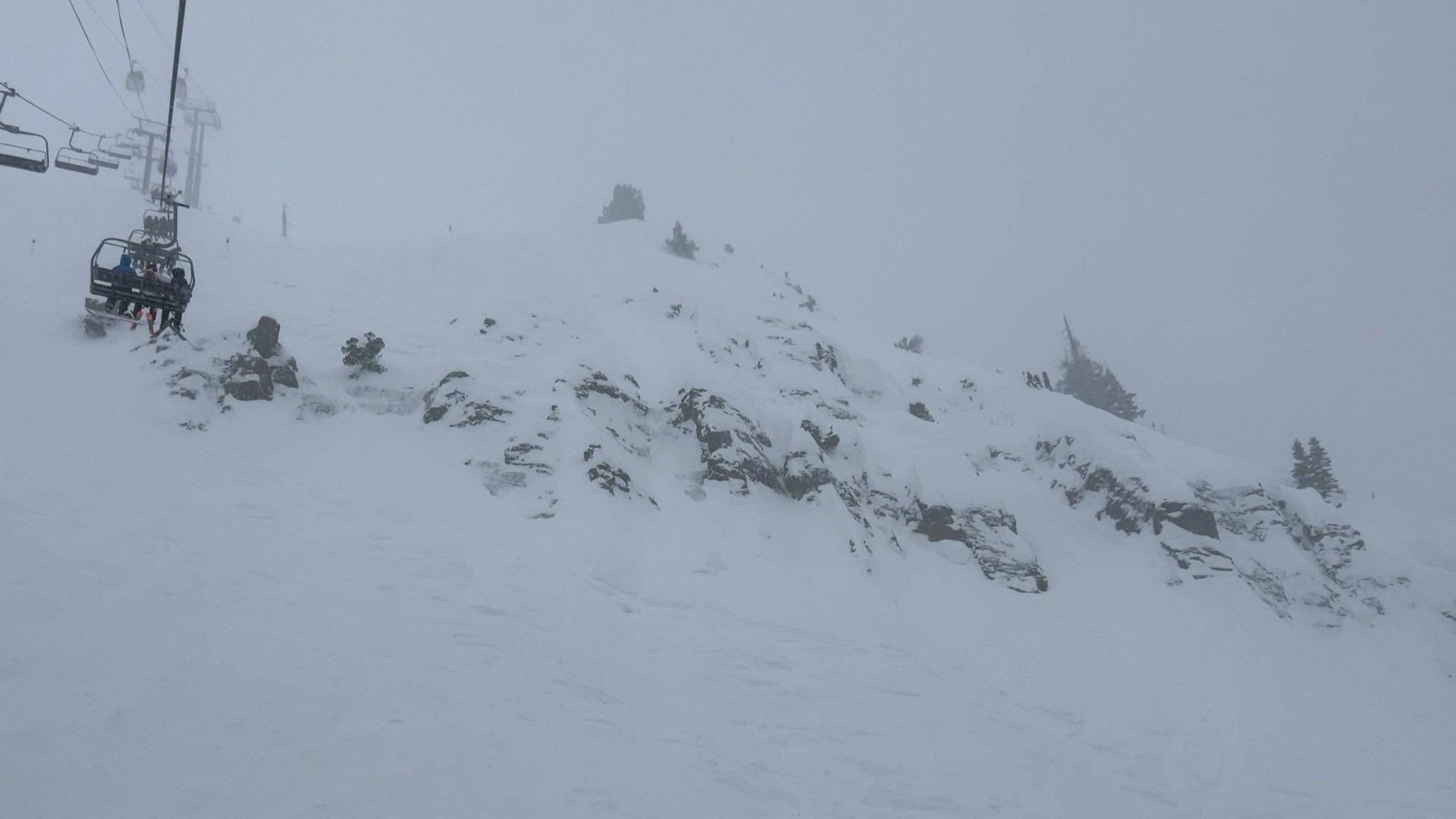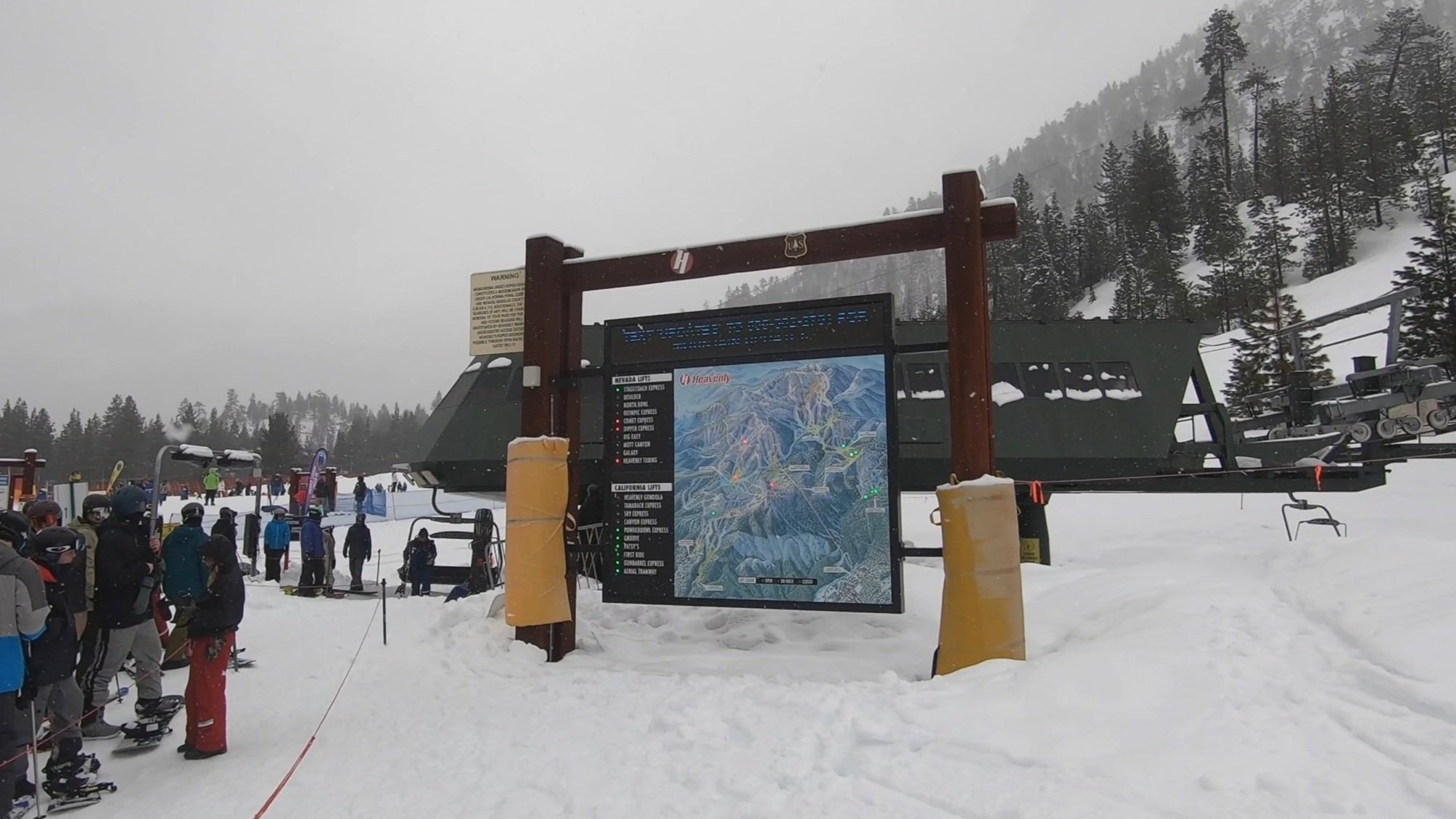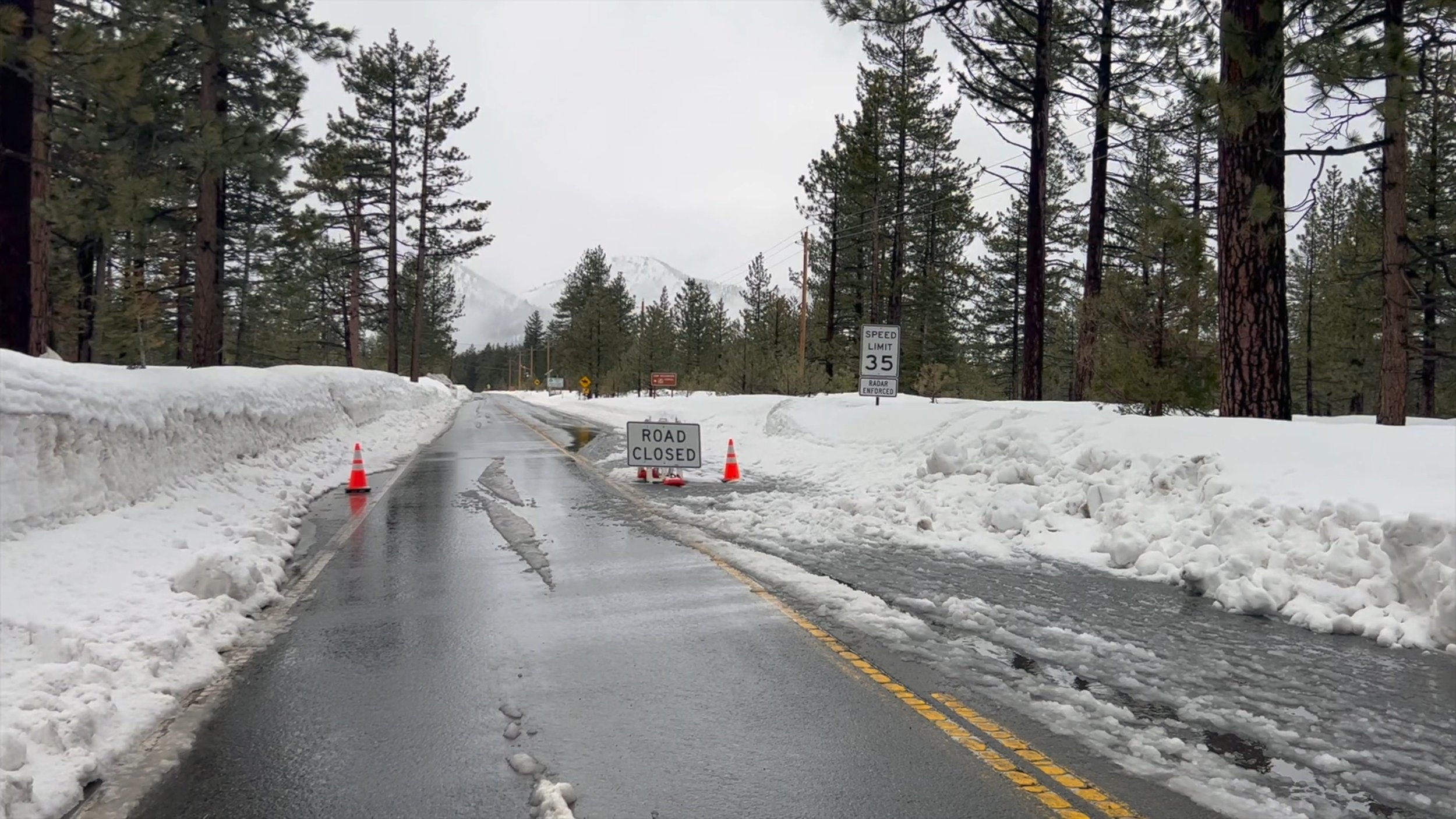Visiting Tahoe During A Record Snowfall Year: What to Expect
If you’ve followed along the ski scene this year, you’ll know that the West Coast’s Lake Tahoe region has had an absolutely insane storm record this winter. Day after day, it feels like you see yet another post about Tahoe getting a multi-foot snow event.
But Tahoe hasn’t exactly been a stranger to wild weather patterns in the past, so just how anomalous is Tahoe’s snowfall this winter? Well, as it turns out, very. In this piece, we’ll go through the most insane aspects of heading to Tahoe for a ski trip this season—including the good, the bad, and the ugly—and how they might impact your ski vacation.
#1: Incredible Resort Conditions
With Tahoe’s record snowfall comes with some of the best snow conditions the region has seen in years. Fresh powder has been frequent and reliable, allowing for steep and deep turns on a regular basis. As soon as the last storm rolls out, it’s only a matter of time before another one rolls in. Tahoe is no stranger to massive storms—even in bad seasons, the region often gets feet of snow at a time—but this season, each multi-foot event has been followed by another, and another… and then another. This means that the massive powder days that are sometimes few and far between in Tahoe have been constant this season. Waist-deep turns days in a row haven’t even been out of the ordinary. Powder skis are an absolute must to make the most out of these incredible accumulation totals.
And while many repeat Tahoe visitors will certainly be familiar with the region’s wet and heavy “Sierra Cement”, much of this season has been an anomaly (at least through mid-March—more on that later). This winter’s temperatures have been much lower than normal, and unlike in typical winters, storms have generally brought light and dry accumulation. This has brought about an absolutely pristine combination of both snow quality and quantity at the Lake Tahoe ski resorts.
The well-above-average snowfall has transformed the terrain footprint at many of Tahoe’s resorts. Several runs have become much different in technicality than in normal years, with the excess snowfall covering up obstacles such as rocks, tree stumps, and shrubs that would normally make some expert-level runs much harder. But thrill-seekers shouldn’t pout just yet—the exceptional accumulation has filled in several lines that wouldn’t be skiable in a typical year, making for fresh extremes that are ripe for mandatory air or straightlining. In fact, the deep, soft snow totals on powder days may be perfect for practicing these gnarly lines.
The famous Palisades Tahoe Fingers are substantially more filled in than in typical seasons, making several expert-level lines easier than usual and opening up new extreme routes that wouldn’t typically be skiable.
#2: Unreliable Terrain Openings
While Tahoe’s conditions have been all-time on the terrain that’s skiable, the relentless snowfall has caused issues with resort terrain openings, meaning that Tahoe’s infamous resiliency issues still extend over to record-breaking snow seasons like this one. The continuous storm patterns have furnished the resorts with plenty of terrain cover, but at the same time, they’ve made for wind conditions and avalanche danger than keep exposed high-alpine terrain closed for protracted periods of time. Even if a bowl area looks absolutely pristine, it may remain closed for days in a row as resort ops wait for avalanche dangers to lessen and winds to die down. So while you may be able to get incredible conditions on your trip to Tahoe, it’s a much tougher bet to be able to ski the full mountain. In fact, after particularly heavy snowfall, there have been several occasions where ski resorts have been forced to close in their entirety.
The ginormous snow totals have also impacted the ability for mountains to conduct routine operational procedures. Many buildings are genuinely buried, as are lifts and snowcats. This means it can take days for patrol to even prepare the equipment needed to open things up after a weather event, and every subsequent storm has just made recovery operations harder. Oh—and good luck figuring out where you’re going, as the signs might be buried too.
Additionally, Tahoe just had its first really wet storm event this past weekend in mid-March. This has been catastrophic for the ski slopes—with several new feet of wet, heavy snow falling on top of the much-lighter-than-usual base, the avalanche danger has been so considerable that most resorts have been forced to close in their entirety. And even absent avalanche issues, lower elevation resort areas have seen rain, resulting in floods both at the bases and on some access roads. This wet layer of snow will probably help preserve the base for a long season ahead, but at least for now, it’s wreaking havoc on a lot of people’s vacations.
Tahoe’s considerable snowfall has resulted in many delayed trail openings and prolonged terrain closures.
#3: Substantial Road Impacts
On top of the already-significant terrain closures, Tahoe’s extreme storm patterns can result in conditions under which you may not be able to even get there. The abnormally high snow totals and relentless storms have resulted in treacherous road conditions, even on some of the best maintained highways. Closures on major roads to get in and out of the Tahoe region—such as Interstate 80, US 50, and Highway 89—have been frequent, sometimes lasting for multiple days at a time. As a result, it may be truly impossible to get to Tahoe—or even worse, to get out.
Don’t even think about driving up if you don’t have both 4WD and snow tires—and even if you do, be prepared to drive through very sketchy road conditions. Chain control operations have been frequent, which may delay your trip by hours even on roads that are technically open. You’ll want to make sure to be very flexible with your travel plans if you’ve booked a trip to Tahoe, as you may have to adjust your trip plans in ways that alter your itinerary for days.
Tahoe access road traffic has been horrendous when the roads are clear, with delays of up to three hours on weekend and holiday mornings.
#4: Wild Variations in Crowds
Given the wild unpredictability in road conditions—and Tahoe’s proximity to the highly-populated California Bay Area—there’s a huge population of skiers and riders who are itching to shred Tahoe’s record powder when the roads are clear.
As a result, crowding has been absolutely insane when I-80 and US 50 are drivable, with weekend and holiday access road traffic reaching up to three hours long at Palisades Tahoe and Northstar, and the situation not being much better in South Lake. The often less-than-ideal road conditions result in accidents that just make the whole situation worse. Lift lines have been generally par for the course—which is to say, still pretty long during drivable peak times—but if it’s the first time an area has opened up in awhile, such as Palisades Tahoe’s Silverado zone this past February, be prepared for the hours-long chaos of the access roads to extend to your wait in line.
On the other hand, when conditions cause road closures—or an impending storm makes return travel unpredictable—powder day lift lines can be almost nonexistent. This means that if your schedule is flexible, you can plan around repeat laps of high-quality powder. However, when the roads are impassible, the weather conditions often impact high-alpine terrain openings as well—and you may find yourself lapping below-treeline, lower-mountain terrain rather than the “whole mountain”. In addition, if you’re staying off-site from the resort, you may not be able to get back to your hotel.
Snow clearing has become a daily chore for many Tahoe locals.
#5: Way of Life Impacts
If you’ve only visited Tahoe during less abundant snow years, prepare to be completely blown away by the look of the place this winter. The sheer amount of snow transforms the demeanor of the region, with every building bearing feet of snow on the roofs, and snowbanks on the sides of roads reaching almost comical levels. In several cases, the snowbanks are so high, they cover road signs and traffic markings. What’s the speed limit here? Who knows? Looking for a store or restaurant along the highway and can’t find it? Better check for a sidewalk behind that snowbank.
However, the excess snow has also caused some meaningful logistical issues for those in the region. The dangerous storms and unreliable road openings have caused supply chain issues, making it tough to reliably get essential needs. The most brutal storm events have kept residents trapped in their houses for days—and have left establishments such as grocery stores almost completely empty. Storm after storm has made snow clearing a routine—just ask any local, and chances are they now allot several hours a day to clear their car, driveway, and general property. And many Tahoe houses don’t have the roofs to support the feet of snow that has fallen on them, so add roof clearing to the chore list as well.
So while it might be a whole lot of fun to hit the slopes during these times, when it comes to being a local, it’s not all sunshine and rainbows.
#6: Surprisingly Resilient Tahoe Sunshine
Even during these insane snowfall times, the sun doesn’t completely disappear in Tahoe. Even in January and February this year, there were periods of breaks for up to two weeks of straight sun with no storms. So while the ratio of storm to sun days has definitely been much more on the snow side this year, the sunny alpine days that Tahoe is known for haven’t completely gone away; and while it can be days before you get your first fully clear day, a storm in the morning can sometimes make way for bluebird conditions in the afternoon.
In addition, the very strong snow base has made for a very different experience skiing on sunny days than in previous years; unlike the past few years, where the poor base layer made for really icy conditions, snow conditions have still been very strong on sunny days, even during breaks in the storms.
Resorts such as Palisades Tahoe will likely be able to stay open through July 4th thanks to the region’s sheer amount of snow accumulation.
#7: Top-Tier Spring Skiing
At a typical ski resort, mid-March is typically when the season starts to wind down. But thanks to these outrageous snowfall totals, some Tahoe resorts have already been talking about operating all the way to July 4th. Indeed, these massive piles of snow won’t be melting for a long time, and it’s pretty much a sure bet that most Tahoe resorts will be able to operate through April, May, and even June should they choose to with reliable terrain openings. Looking to ski in a tank top—or chase your ski day with a beach day or boat visit? This season might be your best bet.
If you don’t have a 2022-23 Ikon Pass, and you’re thinking about one for next season, consider this—Ikon almost always allows early-bird passholders to use the full benefits of the pass for the prior spring season. This means that if you decide to purchase an Ikon Pass for the 2023-24 season, you’ll almost certainly have access to Palisades Tahoe for the rest of spring 2023 starting in mid-April. Depending on the season length, this could mean up to three extra months of skiing access with your pass purchase. This is an incredible deal given the sheer amount of snow the region is sitting on. In addition, given that spring is a very off peak time for skiing, you’ll likely be looking at much cheaper lodging costs than during the peak winter season.
The constant road and terrain closures have made Tahoe an unreliable ski vacation choice, even during the best possible snow years.
Final Thoughts
Ultimately, there’s no question that this is the best ski season Tahoe’s seen in decades, with extraordinary snow totals, exceptionally high-quality accumulation for the region, and a season that will likely extend well into the summer. But the record snowfall hasn’t been without its consequences—the monster weather patterns have wreaked havoc on the local communities, caused severe road closures, and significantly disrupted many people’s vacations. And during peak times with open roads, crowding is as bad as it’s ever been.
If there’s one thing to take away from this winter, it’s this: Tahoe is not a reliable place to book a weeks-in-advance ski vacation during the core winter season, even during the best possible snow years. While you may be risking thin cover or icy slopes during low snow seasons, you may risk not being able to ski at all—or even being able to get to the region—with this much snowfall.
Still, this winter has certainly been one for the history books, and if there’s any place and season to try to swing a spring or summer ski trip to Tahoe, it’s absolutely this one. And when you go, be extra nice to the locals—they’ve been through a lot.
For more information on the ski resorts in the Lake Tahoe region, check out our comprehensive Lake Tahoe mountain reviews. If you’re interested in seeing how they compare to other similar mountains, check out our Lake Tahoe, California, West Coast, and overall rankings.








